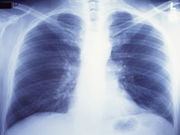Study finds using costly test as first option for follow-up may not improve survival
TUESDAY, Feb. 23, 2016 (HealthDay News) — Many lung and esophageal cancer survivors have positron emission tomography (PET) imaging scans as part of ongoing monitoring, but many of those scans may be unnecessary, according to a study published online Feb. 22 in the Journal of the National Cancer Institute.
Mark A. Healy, M.D., of the University of Michigan in Ann Arbor, and colleagues looked at Medicare data from 101,598 patients nationwide who had lung and esophageal cancer in the mid-2000s and received follow-up care through 2011. More than 22 percent of the lung cancer survivors had a PET scan without first having another type of medical imaging. For esophageal cancer survivors, 31 percent had a PET scan alone.
Use of PET scans to monitor the patients varied widely among hospitals. In some hospitals, PET scans were almost never done. In others, the advanced technology was used often. Some hospitals used PET scans eight times more often than others, the researchers found. But lung cancer patients who received follow-up at a low PET-use hospital were just as likely to survive two years as those who went to a high PET-use hospital.
“Our work shows that almost no one is getting to the three-scan limit set by Medicare. But, with many thousands of patients getting one or two scans across the whole country, this is still a very large number, with very high costs,” Healy said in a university news release. “If the intention of the policy is to curb overuse, this doesn’t seem to be a very effective method, and the agency should reevaluate how it structures its limits.”
Copyright © 2016 HealthDay. All rights reserved.








